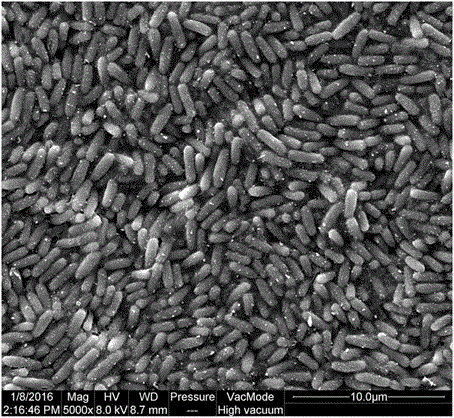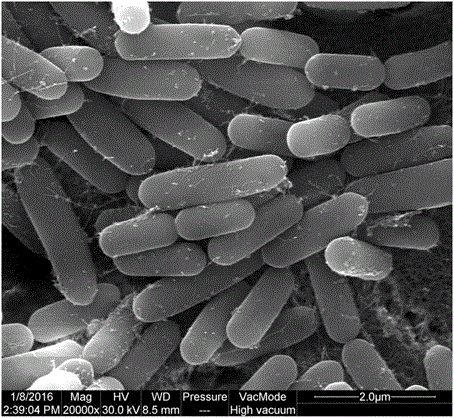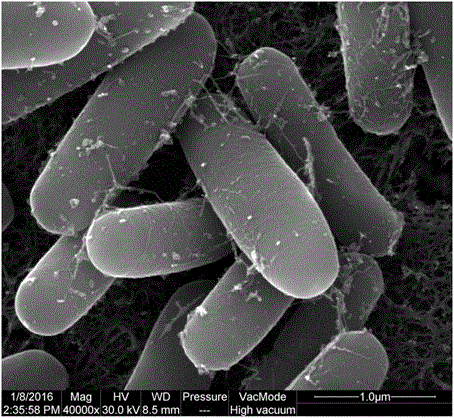Plant antibacterial method implemented by using methylotrophic bacillus nkg‑1
A methylotrophic, bacillus technology, applied in the fields of botanical equipment and methods, plant protection, plant growth regulators, etc., can solve problems such as endangering human health, destroying ecological balance, pesticide environmental pollution, etc., and achieving a pollution-free environment. , No effect of pesticide residues
- Summary
- Abstract
- Description
- Claims
- Application Information
AI Technical Summary
Problems solved by technology
Method used
Image
Examples
preparation example Construction
[0093] Preparation of Methylotrophic Bacillus Fermentation Culture Filtrate Methylotrophic Bacillus was inoculated in LB medium at a ratio of 1:100, shaken at 37°C and 220r / min for 24h. The fermentation broth was collected, centrifuged (10000r / min, 4°C), and the supernatant was sterilized by filtration with a 0.22 μm filter membrane to obtain a sterile fermentation broth.
[0094] Using the mycelial growth rate method to detect the effects of antagonistic bacillus on tomato gray mold, tomato leaf mold, rice blast, pepper anthracnose, apple ring spot, apple rot, cucumber anthracnose, wheat sheath blight, wheat gibberella Blight, asparagus stem rot, corn small spot, cotton wilt, grape black rot, tobacco red spot, peach rhizopus soft rot, and cotton seedling blight.
[0095] Under sterile conditions, take 10 mL of the prepared Bacillus sterile fermentation broth and 90 mL of the melted PDA medium and mix them evenly, and make a plate culture medium containing fermentation broth i...
Embodiment 1
[0104] Embodiment 1: Grape black rot antibacterial method
[0105] Picking the marginal hyphae of confrontation culture, microscopic observation found that the antibacterial effect of NKG-1 on grape black rot mainly manifested as the effect on mycelia and spores. Various metabolites of NKG-1 (including antibacterial proteins, bacteriocins, antibiotics, various cell wall degrading enzymes, etc.) destroy the mycelial wall structure of pathogenic bacteria, causing mycelial expansion, distortion, distortion, and mycelial wall digestion, etc. The middle of the spore constricts, the cell wall dissolves, and the protoplasm leaks out.
[0106] The antibacterial effect of methylotrophic bacillus NKG-1 on grape black rot fungus is as follows: Figure 10 shown.
[0107] Table 2. Mycelia inhibitory effect of methylotrophic Bacillus NKG-1 on grape black rot
[0108]
[0109] (1) Determination results of the effect of methylotrophic bacillus NKG-1 strain fermentation liquid on control...
Embodiment 2
[0126] Embodiment 2: Bacteriostasis method for asparagus stem rot
[0127] The antibacterial effect of methylotrophic bacillus NKG-1 on asparagus stem rot fungus is as follows: Figure 17 shown.
[0128] Table 5. Mycelia inhibitory effect of methylotrophic Bacillus NKG-1 on stem rot of asparagus
[0129]
[0130] Determination of the Control Effect of Methylotrophic Bacillus NKG-1 Strain on Stem Rot of Asparagus in Greenhouse
[0131] Three treatments were set up in the field test: A. biocontrol agent NKG-1500 times liquid; B. 25% metalaxyl wettable powder 600 times liquid; C. blank control. 14m per cell 2 , 3 rows of isolation areas were set up between the plots, and each treatment was arranged in a completely randomized block group, repeated 3 times, and a total of 9 plots were used in the whole experiment. Before the test, divide the plots according to the test plan, open the isolation ditch, and use 15000mL of 1×10 per hectare. 7 cfu / mL biocontrol agent NKG-1. The...
PUM
 Login to View More
Login to View More Abstract
Description
Claims
Application Information
 Login to View More
Login to View More - R&D
- Intellectual Property
- Life Sciences
- Materials
- Tech Scout
- Unparalleled Data Quality
- Higher Quality Content
- 60% Fewer Hallucinations
Browse by: Latest US Patents, China's latest patents, Technical Efficacy Thesaurus, Application Domain, Technology Topic, Popular Technical Reports.
© 2025 PatSnap. All rights reserved.Legal|Privacy policy|Modern Slavery Act Transparency Statement|Sitemap|About US| Contact US: help@patsnap.com



